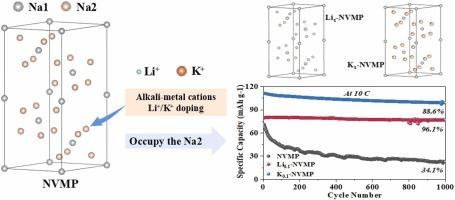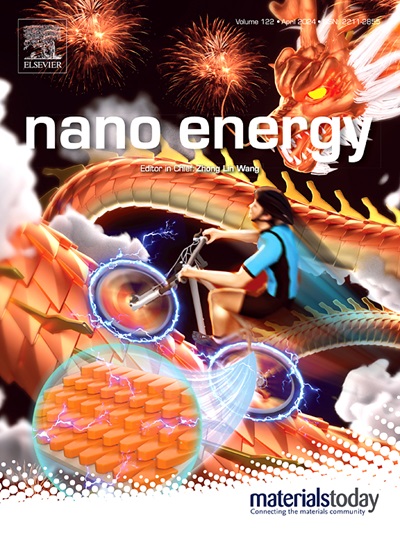用碱金属阳离子取代法制备高性能钠离子电池结构可控的Na4VMn(PO4)3阴极
IF 16.8
1区 材料科学
Q1 CHEMISTRY, PHYSICAL
引用次数: 0
摘要
钠超离子导体(NASICON)型Na4VMn(PO4)3 (NVMP)具有三维结构和高工作电压,作为钠离子电池(sib)正极材料具有很大的潜力。然而,它的性能受到Mn3+的Jahn-Teller效应和Na+缓慢扩散动力学的阻碍,导致容量衰减和结构不稳定。在本研究中,Li+和K+阳离子分别掺杂到NVMP结构中,以提高其电化学性能。li掺杂增强了V3+/V4+氧化还原活性,显著降低了Jahn-Teller效应,在1℃下循环100次后容量保持率为97.7%,在10℃下循环1000次后容量保持率为96.1%。这种高速率稳定性突出了li掺杂在快速循环条件下保持结构完整性和高效离子传输的作用。同时,K-掺杂通过稳定V3+氧化态提高了结构稳定性,在1℃下循环100次后容量保持为110.3 mAh g-1,在10℃下放电容量为99 mAh g-1, x射线光电子能谱(XPS)进一步证实了Li+和K+掺杂都通过调节Mn3+环境抑制了Jahn-Teller效应,从而提高了循环稳定性和Na+阳离子扩散动力学。这些发现强调了碱金属阳离子掺杂作为提高高性能sib NVMP阴极循环性能的策略的有效性。本文章由计算机程序翻译,如有差异,请以英文原文为准。

Structurally controlled Na4VMn(PO4)3 cathodes via alkali metal cation substitution for high-performance sodium-ion batteries
The Na superionic conductor (NASICON)-type Na4VMn(PO4)3 (NVMP), with its three-dimensional framework and high operating voltage, has demonstrated great potential as a cathode material for Sodium-ion batteries (SIBs). However, its performance is hindered by the Jahn-Teller effect from Mn3+ and slow Na+ diffusion kinetics, leading to capacity fade and structural instability. In this study, Li+ and K+ cations were separately doped into the NVMP structure to improve electrochemical performance. Li-doping enhanced the V3+/V4+ redox activity and significantly reduced the Jahn-Teller effect, contributing to a high-capacity retention of 97.7 % after 100 cycles at 1 C and 96.1 % after 1000 cycles at 10 C. This high-rate stability highlights the role of Li-doping in maintaining structural integrity and efficient ion transport under fast cycling conditions. Meanwhile, K-doping improved the structural stability by stabilizing V3+ oxidation states, leading to a capacity retention of 110.3 mAh g−1 after 100 cycles at 1 C and a discharge capacity of 99 mAh g−1 at 10 C. X-ray photoelectron spectroscopy (XPS) further confirmed that both Li+ and K+ doping suppressed the Jahn-Teller effect by regulating the Mn3+ environment, which contributed to the improved cycling stability and Na+ cation diffusion kinetics. These findings highlight the effectiveness of alkali metal cations doping as a strategy to enhance the cycling performance of NVMP cathodes for high-performance SIBs.
求助全文
通过发布文献求助,成功后即可免费获取论文全文。
去求助
来源期刊

Nano Energy
CHEMISTRY, PHYSICAL-NANOSCIENCE & NANOTECHNOLOGY
CiteScore
30.30
自引率
7.40%
发文量
1207
审稿时长
23 days
期刊介绍:
Nano Energy is a multidisciplinary, rapid-publication forum of original peer-reviewed contributions on the science and engineering of nanomaterials and nanodevices used in all forms of energy harvesting, conversion, storage, utilization and policy. Through its mixture of articles, reviews, communications, research news, and information on key developments, Nano Energy provides a comprehensive coverage of this exciting and dynamic field which joins nanoscience and nanotechnology with energy science. The journal is relevant to all those who are interested in nanomaterials solutions to the energy problem.
Nano Energy publishes original experimental and theoretical research on all aspects of energy-related research which utilizes nanomaterials and nanotechnology. Manuscripts of four types are considered: review articles which inform readers of the latest research and advances in energy science; rapid communications which feature exciting research breakthroughs in the field; full-length articles which report comprehensive research developments; and news and opinions which comment on topical issues or express views on the developments in related fields.
 求助内容:
求助内容: 应助结果提醒方式:
应助结果提醒方式:


